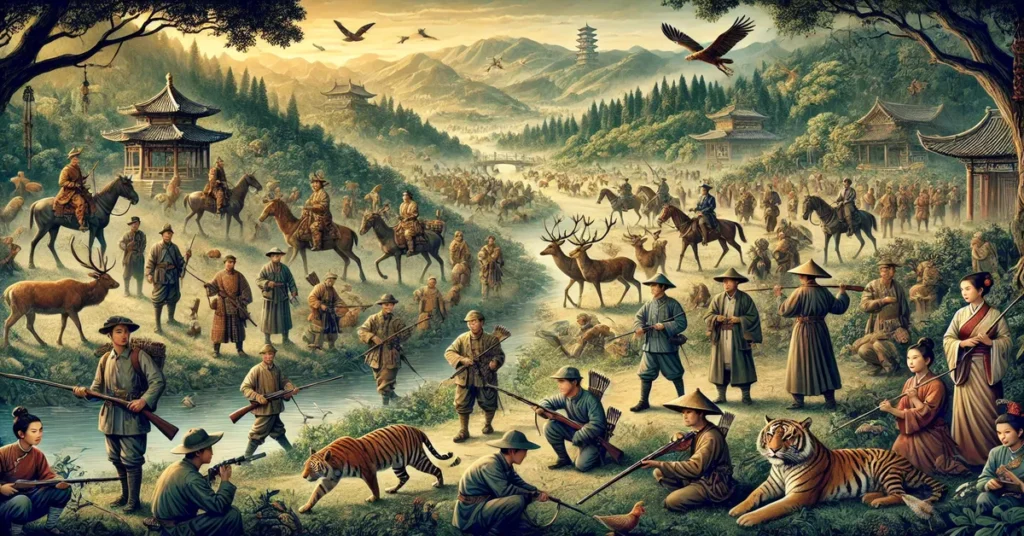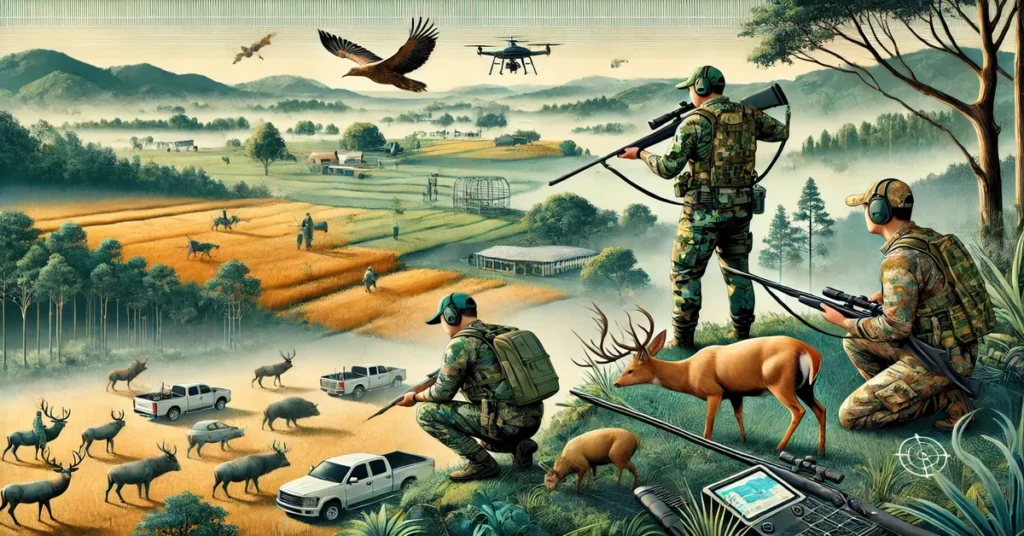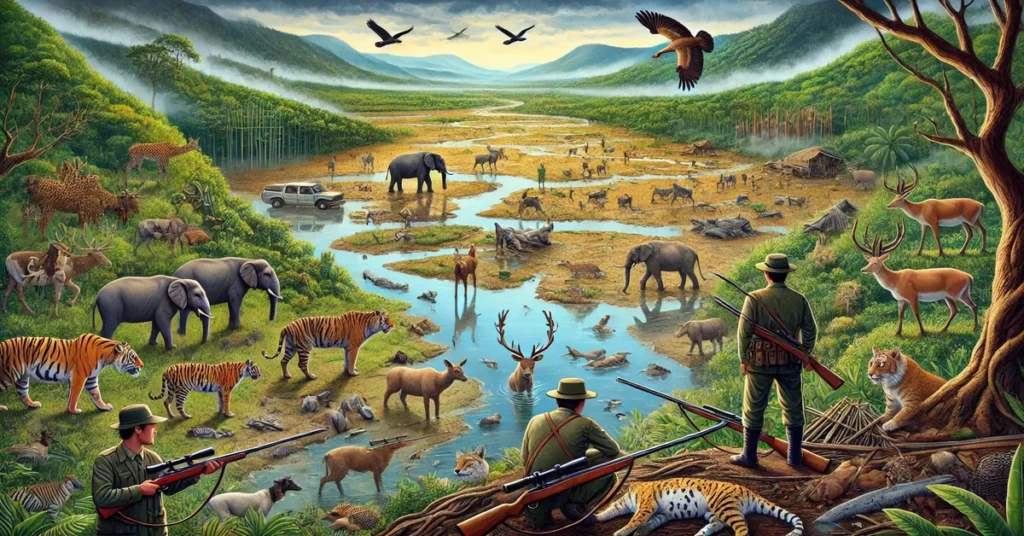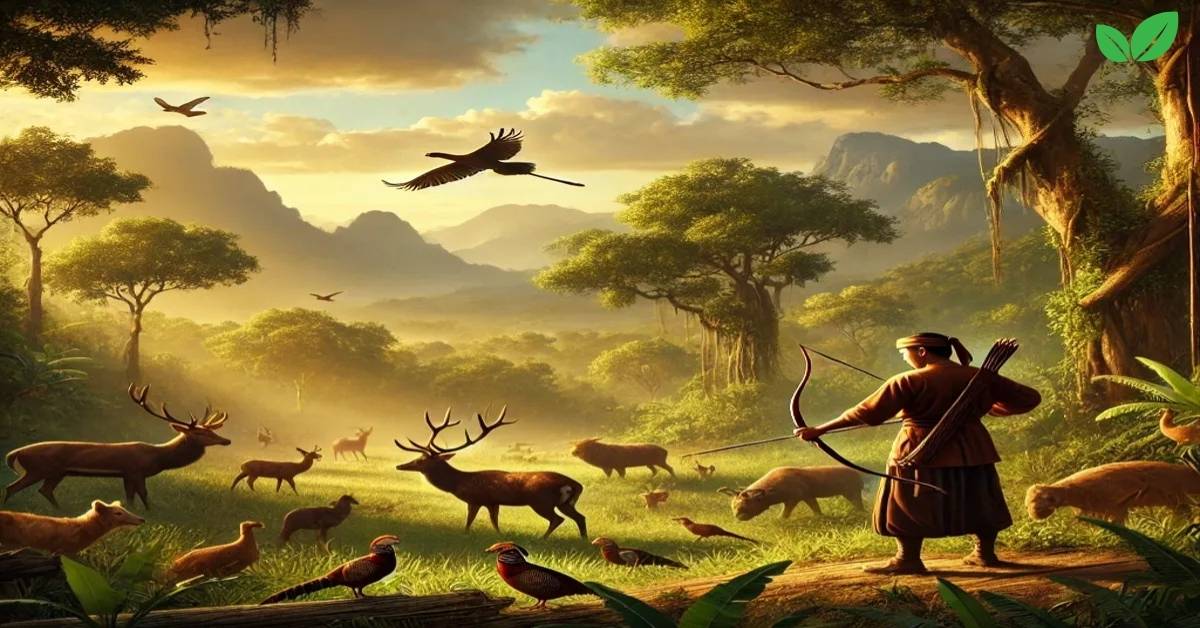Hunting has been a part of human culture for thousands of years, shaping the history and evolution of societies worldwide. In Asia, hunting is a complex practice that spans ancient traditions, subsistence livelihoods, and modern recreational activities. While hunting in Asia has cultural and historical significance in many Asian communities, it also poses challenges to wildlife conservation and ecosystem health. As Asia grapples with rapid urbanization, habitat loss, and biodiversity decline, the impact of hunting on species populations and ecological balance has come into sharp focus. This article explores the multifaceted dimensions of hunting in Asia, its cultural importance, ecological impact, conservation efforts, and the need for sustainable practices to ensure the protection of Asia’s rich biodiversity.
Historical and Cultural Significance of Hunting in Asia

Ancient Traditions and Cultural Heritage
Hunting in Asia has deep cultural roots in many Asian societies, where it has been intertwined with spiritual beliefs, rites of passage, and traditional ways of life. Throughout history, hunting has served as a means of survival, a form of social status, and a source of cultural identity for various communities.
- Hunting as a Spiritual Practice: In some Indigenous communities in Asia, hunting is considered a sacred practice, guided by rituals and spiritual beliefs. For example, among the nomadic tribes of Mongolia, hunting in Asia with golden eagles is a revered tradition that has been passed down through generations. The bond between hunter and eagle is seen as a spiritual connection to the natural world.
- Rites of Passage: In certain cultures, hunting in Asia has historically been a rite of passage for young men, symbolizing their transition to adulthood. These traditions emphasize respect for nature and the animals being hunted, teaching values of responsibility and restraint.
- Cultural Artifacts and Folklore: Hunting has also left its mark on art, folklore, and mythology in Asia. Traditional art forms, such as Chinese ink paintings and Japanese woodblock prints, often depict hunters and their interactions with wildlife, reflecting the cultural importance of hunting in these societies.
Subsistence Hunting and Rural Livelihoods
In rural areas of Asia, subsistence hunting remains a vital source of food and income for many communities. For these communities, hunting is not just a cultural tradition but a means of survival, especially in regions with limited access to agriculture or other forms of livelihood.
- Food Security and Nutrition: In remote regions of Southeast Asia, such as the jungles of Borneo and the highlands of Laos, wild game provides an essential source of protein for Indigenous communities. These communities rely on hunting to supplement their diets with bushmeat, fish, and small mammals.
- Economic Importance: In some cases, hunting also provides a source of income through the sale of animal products like furs, antlers, and medicinal ingredients. In the Himalayan region, for example, yak herders may engage in hunting as a supplementary activity to support their families during harsh winter months.
Modern Hunting Practices in Asia

Recreational and Sports Hunting
In recent decades, recreational hunting in Asia has gained popularity in some parts of Asia, particularly among urban populations with a taste for adventure and the financial means to travel to remote hunting grounds. Recreational hunting is often conducted in a more controlled manner, with hunters seeking trophy animals or specific species as part of guided expeditions.
- Trophy Hunting in Aisa: Trophy hunting involves targeting specific animals, often larger or rare species, for the purpose of displaying them as trophies. In parts of Central Asia, such as Kazakhstan and Kyrgyzstan, hunters seek out animals like ibex, argali sheep, and snow leopards. While controversial, trophy hunting in Asia is sometimes used as a tool for generating revenue for local conservation efforts.
- Guided Hunts and Wildlife Tourism: Some countries have developed hunting tourism industries that attract international hunters. Guided hunts, often for species like wild boar or deer, are marketed as a way to experience Asia’s wilderness. These activities, when regulated, can provide economic benefits to rural communities and contribute to conservation funding.
Illegal Hunting and Poaching
While subsistence and recreational hunting in Asia can be managed sustainably, illegal hunting and poaching remain significant threats to Asia’s wildlife. Poaching for the illegal wildlife trade has pushed many species to the brink of extinction, disrupting ecosystems and causing ecological imbalances.
- Demand for Wildlife Products: The demand for animal parts, such as rhino horn, tiger bones, and pangolin scales, has fueled a lucrative illegal trade that spans across Asia. This trade is driven by beliefs in the medicinal properties of these products, despite a lack of scientific evidence. China, Vietnam, and other countries are major markets for these products, creating a high incentive for poaching.
- Impact on Endangered Species: Poaching has had a devastating impact on some of Asia’s most iconic species, including the tiger, Asian elephant, and rhinoceros. The loss of these apex predators and keystone species can lead to cascading effects on ecosystems, such as an overpopulation of prey species and changes in vegetation dynamics.
Ecological Impact of Hunting on Asia’s Biodiversity

Effects on Species Populations
Hunting in Asia can have significant impacts on wildlife populations, especially when it is conducted without regard for ecological balance. The removal of certain species from ecosystems can alter predator-prey dynamics, disrupt food chains, and reduce genetic diversity.
- Decline of Large Mammals: In many parts of Asia, large mammals like tigers, leopards, and bears have experienced sharp population declines due to hunting and habitat loss. The reduction of these predators can lead to an increase in herbivore populations, which in turn affects vegetation and forest regeneration.
- Impact on Migratory Birds: Hunting in Asia also affects migratory bird populations that travel through Asia during their annual migrations. In regions like the wetlands of Bangladesh and the Philippines, the hunting of waterfowl and shorebirds can reduce the number of birds that stop to rest and feed during migration, affecting their survival and reproduction.
Disruption of Ecosystem Balance
Hunting, particularly when conducted at unsustainable levels, can disrupt the balance of ecosystems and lead to unintended ecological consequences. The removal of certain species can cause shifts in vegetation, soil composition, and even water cycles.
- Trophic Cascades: The removal of predators through hunting can trigger trophic cascades, where the effects of predator loss ripple through the food web. For example, in parts of India, the decline of tiger populations has been linked to an increase in herbivores like deer, which can overgraze forest understories and hinder the regeneration of trees.
- Loss of Keystone Species: Certain species play a disproportionate role in maintaining ecosystem health. For example, the Himalayan black bear is a key seed disperser in the mountainous regions of northern India and Nepal. Hunting these animals can reduce their populations, leading to a decline in seed dispersal and impacting plant diversity in the region.
Conservation Efforts and Sustainable Hunting Practices

Community-Based Conservation
Community-based conservation initiatives have emerged as a key strategy for addressing the challenges of hunting and wildlife conservation in Asia. These initiatives involve local communities in the management and protection of wildlife, offering incentives for sustainable use and stewardship of natural resources.
- Community-Managed Hunting Areas: In Mongolia, community-managed hunting areas have been established to regulate the harvest of species like wild sheep and gazelle. By involving local communities in setting hunting quotas and monitoring wildlife populations, these programs aim to ensure that hunting remains sustainable and benefits both wildlife and people.
- Conservation Incentives: In regions like the Indian Himalayas, conservation organizations have worked with local communities to develop eco-tourism initiatives that offer alternative livelihoods to hunting in Asia. These programs help shift the economic incentives from hunting to wildlife conservation, reducing the pressure on threatened species.
Legislation and Enforcement
Effective legislation and enforcement are critical for curbing illegal hunting and protecting vulnerable species. Many countries in Asia have enacted laws to regulate hunting and protect endangered wildlife, but enforcement remains a challenge due to limited resources and corruption.
- Protected Areas and Hunting Bans: Some countries have established protected areas where hunting is prohibited, providing a refuge for endangered species. For example, Nepal’s Chitwan National Park is home to a significant population of rhinos and tigers, protected by strict anti-poaching measures and armed patrols.
- International Cooperation: Combatting wildlife trafficking requires international cooperation, as the illegal trade often spans multiple countries. Organizations like the Convention on International Trade in Endangered Species of Wild Fauna and Flora (CITES) work to regulate trade in endangered species and coordinate efforts to dismantle trafficking networks.
Sustainable Hunting Models
In some cases, sustainable hunting models have been proposed as a way to balance conservation goals with the cultural and economic needs of communities. These models focus on maintaining healthy wildlife populations while allowing for regulated, low-impact hunting activities.
- Quota-Based Hunting: Quota-based hunting systems set limits on the number of animals that can be hunted each year, based on scientific assessments of population health. This approach aims to ensure that hunting in Asia does not exceed the reproductive capacity of the species. Quotas can be adjusted annually based on population surveys and ecological data.
- Revenue-Sharing Programs: Revenue from regulated hunting, such as fees for hunting in Asia permits or eco-tourism, can be directed back into conservation efforts. This model has been applied in parts of Central Asia, where funds from trophy hunting are used to support wildlife monitoring and habitat protection.
The Future of Hunting in Asia: Challenges and Opportunities

Addressing Human-Wildlife Conflict
Human-wildlife conflict is a major challenge in many parts of Asia, where growing human populations and shrinking natural habitats bring people and wildlife into closer contact. In some cases, hunting in Asia has been used as a means of controlling populations of animals that pose a threat to crops or livestock.
- Reducing Retaliatory Killings: When predators like snow leopards, wolves, or tigers prey on livestock, herders may resort to retaliatory killings. Conservation programs that provide compensation for livestock losses or build predator-proof enclosures can help reduce the incentive for such killings.
- Community Engagement and Education: Educating communities about the ecological importance of predators and the benefits of coexistence can help reduce conflicts. Conservation organizations work with local people to develop non-lethal deterrents and promote coexistence strategies, such as using guard animals or changing grazing practices.
Integrating Indigenous Knowledge
Indigenous knowledge and traditional ecological practices can play a valuable role in wildlife conservation and sustainable hunting practices. Many Indigenous communities have a deep understanding of local ecosystems, which can inform modern conservation efforts.
- Traditional Knowledge in Wildlife Management: In the forests of northern Thailand, Karen communities use traditional knowledge to manage hunting practices sustainably. They monitor wildlife populations, follow seasonal hunting in Asia restrictions, and share knowledge about animal behavior, helping to maintain a balance between hunting and conservation.
- Incorporating Indigenous Practices in Policy: Recognizing and incorporating Indigenous knowledge into national and regional conservation policies can enhance the effectiveness of wildlife management. By involving Indigenous communities in decision-making, governments can create more inclusive and culturally sensitive conservation strategies.
Balancing Conservation with Cultural Values
The future of hunting in Asia lies in finding a balance between preserving cultural traditions and protecting biodiversity. While the cultural significance of hunting cannot be overlooked, it must be managed in a way that ensures the survival of Asia’s unique wildlife.
- Respecting Cultural Traditions: Efforts to regulate hunting in Asia should consider the cultural importance of hunting for certain communities, working to find solutions that respect traditions while prioritizing conservation. This may include allowing limited subsistence hunting or seasonal hunting within protected frameworks.
- Promoting Conservation Education: Increasing awareness about the ecological impact of hunting in Asia and the importance of protecting endangered species can help shift cultural attitudes. Conservation education programs in schools and community centers can foster a sense of stewardship and appreciation for wildlife.
Conclusion: Towards a Sustainable Future for Hunting in Asia
Hunting in Asia is a complex issue that intersects with culture, tradition, and economic needs, as well as the urgent challenges of wildlife conservation. While hunting has been a way of life for many communities, the pressures of modern development, illegal wildlife trade, and ecological imbalance require a rethinking of how hunting is practiced and managed.
By embracing sustainable hunting models, supporting community-based conservation, and integrating traditional knowledge, Asia can find a path that respects cultural heritage while ensuring the protection of its unique biodiversity. The goal is not to eliminate hunting altogether but to manage it in a way that allows humans and wildlife to coexist in harmony.
In a world where the survival of many species hangs in the balance, the choices we make today will determine whether future generations can continue to experience the rich natural heritage of Asia. A sustainable approach to hunting, rooted in respect for nature and science-based management, can help secure a future where both people and wildlife thrive.
Read More: Coniferous Forest Animals: A Vital Part of the Ecosystem

